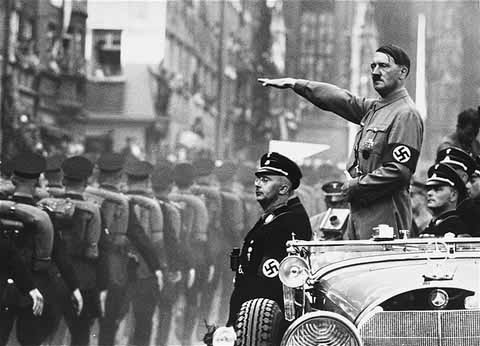by David

Adolf Hitler: Not a Socialist
Three days ago it was Yom HaShoah, the Jewish Holocaust Remembrance Day. It’s a solemn occasion, one that should not be politicized. On this next day, however, I’d like to address a political pet peeve of mine, namely the view that fascism, specifically Nazism, was somehow an ideology of the Left. It was not.
People often make this mistake by lumping Nazi Germany and Stalinist Russia together as two sides of the same totalitarian coin. Both regimes were responsible for monstrous crimes, yet the ideological underpinnings behind them should be distinguished and understood, rather than inaccurately melded together. Fundamentally, fascism and its Nazi manifestation were ideologies of the extreme Right, that advanced not only a racist populism but also a socially Darwinistic, hierarchical individualism that celebrated competition and allowed for for some capitalist industry to coexist alongside and in league with a powerful state.
I was spurred to write this post after listening to right-wing talk radio, where the announcer described fascism as an ideology of the left, the result of the expansion of Big Government. These scare tactics are used to form a slippery slope argument, namely that the welfare state leads to the gas chambers. Friedrich Hayek advanced a version of this argument in his famous and erroneous work, The Road to Serfdom, particularly in his chapter “The Socialist Roots of Nazism.” It is certainly true that fascism represents the worship and expansion of state power. Yet it can and did exist alongside capitalism, as was the case in Nazi Germany. Though Adolf Hitler led the National Socialist German Workers’ Party (Nazi), Hitler was not a socialist.
The reasons for this are manifold. First is the obvious: socialist and communist parties existed in Weimar Germany alongside the Nazi party and indeed were its bitter enemy (though Communists and Nazis occasionally colluded too). Second, and equally obvious, Nazism divided Germans along racial rather than class lines. Jews and other enemies of the state were enemies regardless of class, and the Aryan ideal could be achieved at any socioeconomic level.
Third, the Nazi regime did not completely take over all large businesses and industries, but rather colluded with them, most famously with chemical company I.G. Farben. This is a crucial mistake people make about fascism: businesses in fascist states like Hitler’s Germany are not necessarily government owned, and can to some degree function within a market-oriented capitalist framework subject to the laws of supply and demand. Fascism, in this totalitarian form, functioned occasionally with brute force, like on Kristalnacht, but often through more subtle means. Fascism more frequently used coercive force like that at play in Jeremy Bentham and Michel Foucault’s Panopticon, a prison that exerted social control through fear of being watched rather than naked displays of state power. This, along with Hitler’s popularity, rendered capitalist business compatible with Nazism, so long as those involved with it were Aryans who obeyed the regime.
Most important, we know Nazism was an ideology of the far right because of the very logic behind it. Unlike socialism, Nazism was a hierarchical, Socially Darwinistic vision that encouraged competition, and showed disdain for the masses, who Hitler called “mentally lazy.” Most crucially, it did not denigrate individualism, but in fact celebrated it. This is evident in Hitler’s major work, Mein Kampf.
I’m not simply referring to Hitler’s attacks on “Jewish” Marxism and Bolshevism, which he argued was a “comrade” to the equally Jewish “greedy finance capital.” Hitler believed that “the stronger must dominate and not blend with the weaker.” Hitler extrapolated from individual achievement, “true genius,” to racial achievement. Indeed, to ignore racial hierarchy led to an “underestimation of the individual. For denial of the difference between the various races with regard to their general culture-creating forces must necessarily extend this greatest of all errors to the judgment of the individual.” Hitler celebrated the “free play of forces” that enabled both individual and racial advancement in Darwinian struggle. He loved sports, especially boxing, as they served “to make the individual strong, agile and bold.”
Hitler’s individualism and elitism emerged most strongly in his chapter on “Personality and the Conception of the Folkish State.” Hitler distorted Nietzschean philosophy to elevate certain individuals, like himself, above all others. He hoped to organize society that placed “thinking individuals above the masses, thus subordinating the latter to the former.” This would be true of economic life as well. “in all fields preparing the way for that highest measure of productive performance which grants to the individual the highest measure of participation.”
I could go on. My point here is not to politicize, but to de-politicize. Hitler was of course not a pure capitalist, and Nazi Germany not a purely capitalist state. Nazi Germany’s economy relied on considerable amount of state control and even some Keynesian economics. Many socialists showed similar disdain for the masses. But, and this is crucial, Hitler was not really interested in economics, nor was economic policy central to the Third Reich. Expansion of government and state power was less important to the regime than socially Darwinistic racial competition.
To conclude, I’ll simply say this: socialism and the welfare state should not be advanced by criticizing Nazi Germany and invoking the spectre of the Holocaust, but they should not be attacked that way either.